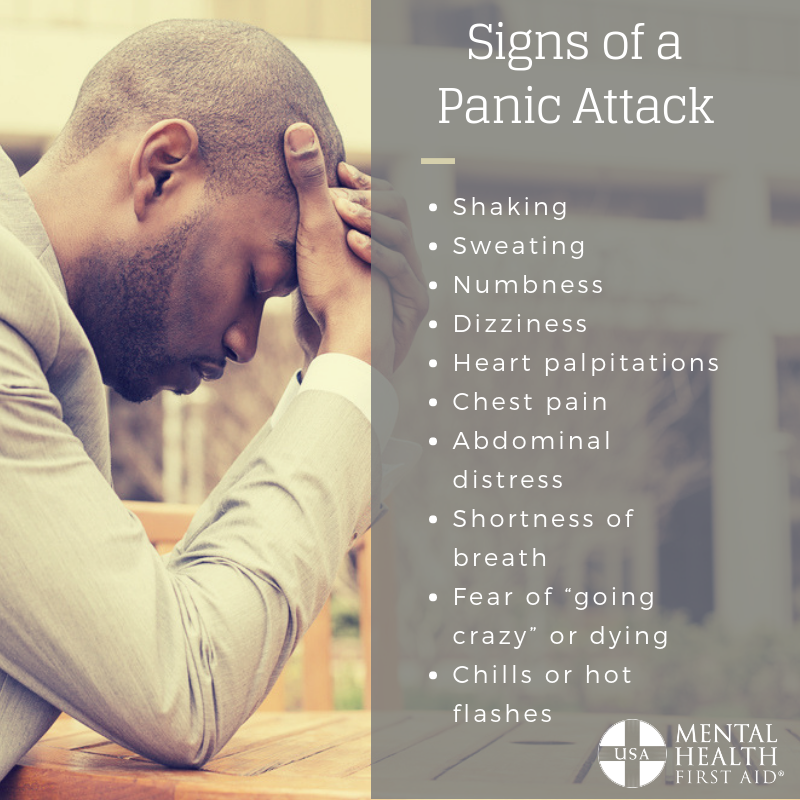NYTiimes - The Daily podcast- A Special Episode for Kids: The Fear Facer Nine-year-old Ella was terrified of tornadoes and getting sick. So she did something that was even scarier than her fears: confront them. Guests: Ella Maners and her mother, Katie Maners, and Julia Longoria, a producer for “The Daily.”
Below is some helpful information from the organization Mental Health First Aid.
We are also including some excellent information from Mental Health First Aid
Six million American adults have panic disorder, meaning they experience repeated episodes of intense fear called panic attacks.
- Even people without panic disorder can have panic attacks. Overall, more than one in five people experience a panic attack in their lifetimes.
Do you know what to do if you see someone experiencing one?
If not, don’t worry. This guide will explain how to help someone who is having a panic attack so you’ll feel prepared if you ever encounter a person who needs help.
How to Tell if It’s a Panic Attack
Before you can help a person who is having a panic attack, you need to know if it’s because of fear or anxiety they’re experiencing or if there’s a physical explanation.
Here are 10 symptoms of panic attacks to look for:

IMPORTANT NOTE: Do these symptoms look familiar? They’re also signs of cardiac distress. It’s difficult to know if a person is experiencing a panic attack or a heart attack.
The best thing to do is ask if the person has had a panic attack before. If they haven’t and they don’t think they’re having one now, call 9-1-1 and follow physical first aid protocol. If the person loses consciousness, call an ambulance, check for breathing and pulse and apply physical first aid principles. You can also check for a medical alert bracelet or necklace for more information.
How to Help Someone Who Is Having a Panic Attack
If you suspect someone is having a panic attack, Mental Health First Aid teaches you to follow the ALGEE action steps:
- ASSESS for risk of harm: Ask them if it’s happened before and if they think they’re having one now. If it’s something they’re familiar with and they suspect it is, ask them if they’d like help. If they do, introduce yourself (if it’s a stranger).
- LISTEN non-judgmentally: Ask directly what they think might help (for example, moving away from a crowded area or sitting down). Don’t assume you know what’s best for them.
- GIVE reassurance and information: Remain calm and reassure the person that they’re most likely experiencing a panic attack and that it’s not dangerous. Explain that while what they’re feeling is frightening, the symptoms will pass. As you talk, use short sentences and speak in a clear, firm manner. Be patient and stay with them throughout the attack.
IMPORTANT NOTE: You might have seen on TV that people having panic attacks should breathe into a paper bag. This is no longer considered a best practice because the person ends up breathing in carbon dioxide, which could cause them to pass out. If someone is breathing rapidly, don’t call attention to their breathing. Simply stay calm and model a steadier breathing rate.
- ENCOURAGE appropriate professional help: When the panic attack is over, provide the person information related to panic attacks if they don’t know about them or don’t know where to acquire relevant resources. If they seem concerned, explain that there are effective treatments for panic attacks and that there’s help available to them.
Here are some useful resources you can share:
- ENCOURAGE self-help and other support strategies: Encourage the person to tap into other support sources, like family, friends or any communities they’re part of. Support groups of people who also experience panic attacks could be useful, as well.
To learn more strategies for supporting people, take Mental Health First Aid. The course will teach you how to identify, understand and respond to signs of mental health or substance use issues. Become part of a movement to change the culture around mental health.
And don’t forget: After you’ve helped someone, remember to practice self-care. It’s not easy to help a person experiencing a mental health issue, so it’s important to take time for yourself.
Finally, be proud! Even if you’ve just read this article, you’re one step closer to helping someone in their time of need.


